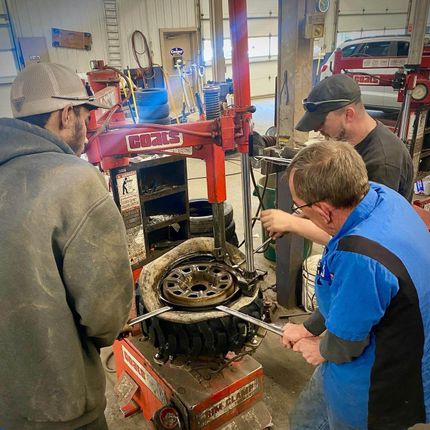Morris Tires: Your Partner for Professional GMC Tires Service
Wiki Article
Tire Service: The Influence of Climate Condition
When it involves making certain optimum efficiency and safety when traveling, comprehending the effect of weather condition problems on tire solution is important. From scorching warm to icy roadways, each weather condition aspect can considerably affect tire performance and general driving experience. By diving right into the results of differing weather problems on tires, drivers can gain beneficial understandings that might enhance their vehicle's performance and longevity. In this discussion, we will certainly explore the elaborate relationship between weather condition conditions and tire service, shedding light on the significance of weather-specific tire maintenance methods and considerations.Heat and Tire Efficiency
When subjected to high temperature levels, tires experience modifications in efficiency that can significantly impact car safety and handling. The warmth created from long term driving or warm weather problems creates the tire rubber to soften, leading to lowered walk life and boosted wear.
Winter Results
Cold climate problems can have a significant effect on tire efficiency and safety and security. In chilly climate, tires may also shed air stress extra quickly, which can influence taking care of and fuel performance.To reduce the results of cold weather on tires, it is essential to routinely inspect tire pressure and inflate them to the producer's recommended levels. Making use of wintertime or all-season tires made for winter conditions can also enhance grip and grasp on icy or snowy roadways. Proper tire upkeep, including regular examinations for wear and damage, ends up being much more crucial during colder months to make sure optimal performance and safety and security.
Rainy Issues Effect
During stormy problems, tire performance and safety and security can be dramatically affected by the damp road surface areas and minimized visibility. The step pattern of tires plays an important function in preserving grip on damp roadways. Tires with damaged footsteps are a lot more susceptible to hydroplaning, where a layer of water develops in between the tire and the roadway surface, bring about loss of traction. To fight this, click over here now chauffeurs need to on a regular basis evaluate their tires for appropriate step depth and think more information about purchasing tires specifically designed for damp problems.Furthermore, stormy weather can also reduce visibility, making it challenging for vehicle drivers to see the roadway ahead plainly (GMC Tire Service). In such conditions, it is necessary to change driving rates accordingly and preserve a risk-free adhering to range to enable unexpected stops. Correctly filled with air tires can also aid in preserving control on damp roadways by giving far better handling and hold
Snow and Tire Safety And Security
Snow-covered roadways present one-of-a-kind challenges for vehicle drivers, stressing the relevance of appropriate tire selection and maintenance. When driving in snowy problems, having the appropriate tires can make a significant difference in safety and efficiency. Winter season tires are developed with unique rubber substances and walk patterns to give better traction on snow and ice compared to all-season tires. The deeper treads and sipes of winter tires help hold the road better, minimizing the danger of moving and slipping.
It is essential to adhere to maker instructions when making use of and setting up tire chains to prevent damage to the tires and automobile. By picking the ideal tires, preserving correct rising cost of living, and taking into consideration additional grip help like tire chains, vehicle drivers can improve their safety when browsing snow-covered roads.
Weather-Related Tire Maintenance
Weather-related tire maintenance includes a variety of methods intended at guaranteeing optimum tire feature and long life in different climate situations. One crucial element of weather-related tire maintenance is tire stress law. Inspecting tire step routinely and replacing tires when walk wear reaches a particular deepness is important for preserving traction and stability in negative weather.
Verdict
To conclude, climate condition have a considerable impact on tire efficiency and safety and security. From heat influencing tire stress and wear to cold climate reducing grip, it is vital to take into consideration the weather condition when keeping and using tires. Wet conditions can lower grasp and bring about hydroplaning, while snow can boost the danger of accidents if tires are not appropriately furnished. Weather-related tire upkeep is important in ensuring optimum performance and safety and security when driving.In this conversation, we will certainly explore the complex partnership between climate problems and tire service, dropping light on the relevance of weather-specific tire maintenance practices and factors to consider.

Report this wiki page